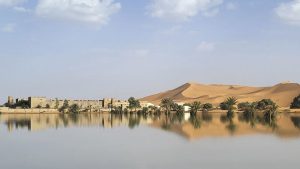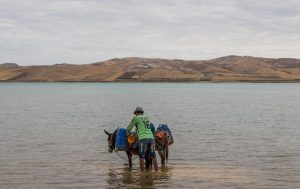
For the first time in half a century, parts of the Sahara Desert are submerged in water, creating rare blue lagoons amidst the arid sands. A powerful downpour transformed one of the driest regions on earth into a surreal landscape, leaving both locals and tourists in awe. This historic event, reported by the Associated Press, occurred in Southeastern Morocco last September.
Unprecedented Rainfall in a Parched Land
The usually sun-scorched Sahara received an unexpected gift of rain. Southeastern Morocco, a region accustomed to harsh droughts, saw more rainfall in two days than it typically gets in an entire year. This sudden change in weather turned sand dunes into temporary lakes, as palm trees and cacti stood reflected in the tranquil waters.
One of the areas most affected was Tata, where rainfall exceeded yearly averages by a significant margin. Even more dramatic was the situation in Tagounite, a village 450 kilometers south of the capital, Rabat, which experienced over 100 millimeters of rain in just 24 hours. This level of precipitation is unheard of in such a dry region, making the flooding both extraordinary and destructive.
Lake Iriqui Fills Up for the First Time in 50 Years
One of the most stunning images to emerge from this rare event is that of Lake Iriqui, a dry lake bed that hadn’t seen water in 50 years. The once-barren lake, usually a vast expanse of cracked earth, has been transformed into a shimmering body of water, surrounded by sand dunes. Locals and tourists alike flocked to the site, driving 4x4s through the flooded desert, marveling at the scene that looked more like an oasis than the typical arid Sahara.
“This much rain, in such a short space of time, hasn’t happened here for 30 to 50 years,” said Houssine Youabeb of Morocco’s General Directorate of Meteorology. The sheer volume of rainfall was a result of an extratropical storm, a rare weather phenomenon for this region. Meteorologists have warned that while this event is extraordinary, it could signal a change in the climate that brings more frequent storms to the Sahara Desert.
A Mixed Blessing for Morocco
Although the downpour brought a welcome relief to drought-stricken areas, the flooding also had a devastating impact. Morocco has been grappling with six years of drought, leading to severe water shortages. The recent rainfall is expected to help replenish depleted groundwater levels and refill the country’s reservoirs, offering hope for improved water security.
However, the heavy rains also had tragic consequences. More than 20 people lost their lives due to the floods, with the hardest-hit regions being in both Morocco and neighboring Algeria. Farmlands were also severely damaged, with crops being washed away in the deluge. The Moroccan government has already released emergency aid to assist affected farmers and to help those who lost loved ones in the disaster.
Climate Change and Its Impact on the Sahara
The flooding of the Sahara Desert is a stark reminder of the unpredictable nature of climate change. While extreme weather events have been increasing worldwide, this rare flooding highlights how even the driest places on earth are not immune to climate shifts. According to experts, the Sahara region could see more unusual weather patterns in the future, including more frequent storms and rainfall.
For now, the sight of water flowing through the sands of the Sahara is both a wonder and a warning. As tourists drive through the flooded areas, snapping photos and taking videos of this rare event, locals are left to ponder the long-term consequences of such dramatic changes in their environment. Will the desert see more rain, or will the drought return with even greater intensity?
Looking Ahead
While the floods have brought temporary relief from drought, the long-term impact on Morocco’s water resources remains uncertain. Farmers and local communities are hoping that this rainfall will provide much-needed hydration for the land and help them recover from years of dry conditions. At the same time, the government and meteorologists are closely monitoring the situation to see if these types of storms will become more frequent.
The rare flooding of the Sahara Desert has captivated the world’s attention, reminding us that even the most extreme climates are subject to change. As the desert lakes slowly dry up and the blue lagoons fade back into sand, the memory of this historic event will live on as a testament to the power of nature and the growing impact of climate change on our planet.


